ARK Coin Review: The Blockchain Solution For Everyone
Increased blockchain usage is a good thing, right? ARK is a fairly new project aimed at increasing user adoption of blockchain technology, among other things.
But, one of the key concepts in the ARK whitepaper is that they will bring blockchain technology to the masses. They plan on doing this by providing “Practical Services for Real People” as well as Fast Secure Core Technology”.
One way ARK is doing this is by creating an ecosystem that will allow any individual or business to create their own standalone blockchain in a matter of minutes. To get this to spread as quickly and broadly as possible the ARK team has put an emphasis on incorporating as many coding languages and blockchains as possible, and providing the best possible user experience.
In this ARK Coin review we will take an in-depth look at the project as well as the technology and prospects for the ARK coin itself.
ARK History
The ARK blockchain was launched in February 2017 by a group of 27 members spread across the globe, making for a truly decentralized team. Currently, the core team consists of 27 members as well.
One of the primary founders, and the current CTO of ARK, is FX (Francois-Xavier) Thoorens, who was also a core developer at Lisk prior to working on the ARK project.
ARK was modeled heavily on Bitshares, Lisk and Crypti, three older projects all using the Delegated Proof of Stake (dPoS) consensus algorithm. This is a variant of traditional Proof-of-Stake (PoS) consensus algorithms.
How Does ARK Work?
There are several core features being built into the core ARK ecosystem which will help the project achieve its goal of making blockchain technology more accessible. These key features include:
- SmartBridges
- Alternative Programming Languages
- Push Button Deployable Blockchains
Smart Bridges
The Smart Bridge concept will be used by ARK to create “bridges” between different incompatible blockchains. In essence ARK will become an intermediary between the blockchains, allowing for communication between disparate chains, and the ability to trigger events on other chains. While other projects have been working on a similar function, this remains something that isn’t currently possible.
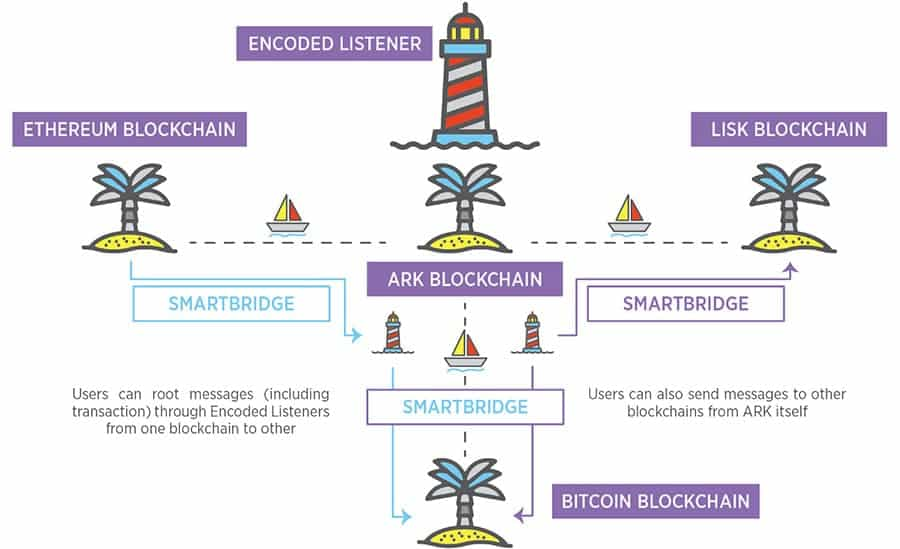
The really great thing is that SmartBridges can be enabled with nothing more than a snippet of code provided by ARK.
One use case for SmartBridges would be through exchanges, which could use encoded listeners to determine when a transaction is an exchange transaction, and then process those transactions automatically while still charging their usual fees.
For example, a user could send 100 ARK to their Coinbase wallet, and Coinbase would recognize the transfer as an exchange transaction and automatically convert the ARK to ETH before depositing it in the users wallet.
Alternative Programming Languages
The ARK developers were very clear in their intention to allow development in as many coding languages as possible, thus including as many software developers as possible.
In addition to supporting over a dozen different programming languages, developers have access to SDKs in the following languages (speeding development):
- C++
- .NET
- Elixir
- Go
- Java
- JavaScript
- Laravel
- PHP
- Python
- RPC
- Ruby
- Rust
- Swift
- Symfony
- Wolfram
The ARK team is also promising support for R, C, Advanced PowerShell, Rust, and C++ will soon be available.
Push Button Deployable Blockchains
This will allow anyone to easily form the ARK blockchain and create their own blockchain project. Yes, it’s similar to Ethereum, but without the cost. And these newly deployed chains will come with SmartBridges already fully functional.
Delegated Proof-of-Stake
Rather than using the controversial proof-of-work consensus mechanism, ARK is running with a Delegated Proof of Stake consensus algorithm. This means no expensive hardware and huge electricity usage is needed, as the ARK network is secured by delegates. Anyone can be a delegate, but currently only 51 people actually become delegates, and these are chosen by the ARK token holders through a voting system.
Each delegate receives 2 ARK for each block they forge, and since blocks are forged every 8 seconds these delegates can make upwards of 200 ARK per day.
ARK token holders are each allowed one vote for delegate, which costs 1 ARK. It is also possible to unvote your delegate and vote for a different delegate and the cost is 1 ARK each time you vote or unvote. The more ARK tokens held, the more powerful and individuals vote is.
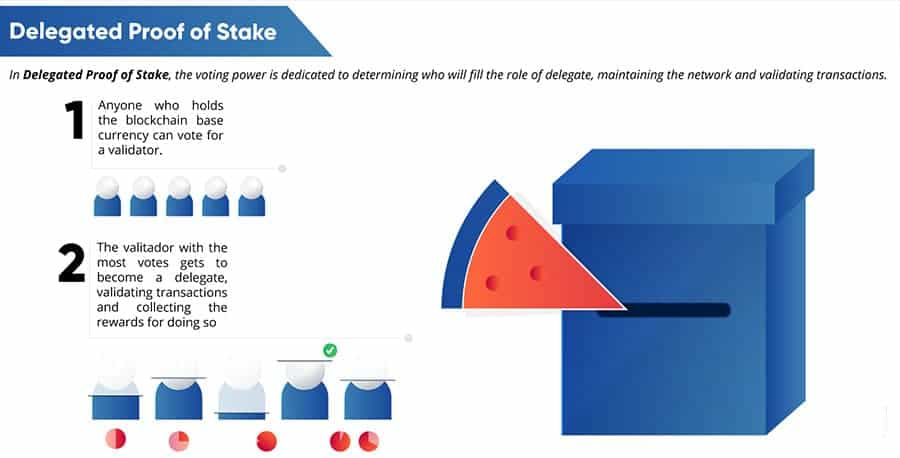
You’ll find that delegate candidates have written proposals detailing how they will work to secure the network and make ARK better for everyone. One popular way of obtaining votes is through profit sharing. Since each of the 51 delegates receives a reward for forging new blocks, it’s possible for them to share these rewards with those that vote for them in a type of dividend system.
Another popular course for prospective delegates is to run a development project that builds on or improves the ARK ecosystem, and in many cases these delegates offer an equity stake in the new project, or provide services for free.
The ARK Team
The ARK team has been the driving force that continues to move the project forward.
They are a strong group of individuals, led by founder, CEO and President Francois-Xavier (FX) Thoorens. Prior to founding ARK, he was a core developer for Lisk, as well as the founder of the donations platform Donatio.fr. His background is in 3D software development.

The vice-president and a founding member of ARK is Rok Cernec. Much of the community outreach is handled by Rok, and you’ll find his name on nearly all the project updates posted on the Ark blog.
The Chief Technology Officer for ARK is Kristjan Kosic who is a Ph.D. in Computer Science and in addition to working directly as a programmer also has experience on the business side as the CEO of health services company ADORA.
The ARK Community
As you might expect from a project that began in 2016 ARK has a pretty large community of users. The most obvious indication of this is in their sub-Reddit, which has nearly 22,000 readers, and their Twitter account, which has 63,500 followers. The sub-Reddit is also pretty active, with several posts per day and a large number of comments and discussions.
In addition to the obvious social accounts, ARK also has close to 9,000 followers of their Facebook page, which is pretty large for a blockchain project. The YouTube channel isn’t quite as impressive, with just 3,000 subscribers, but the team continues posting videos – roughly 1 per month.
There is also a Telegram channel and it has just over 2,500 subscribers. When I checked on a Friday afternoon in the U.S. there were roughly 150 people online.
The ARK team also has a presence on Discord, Medium, Slack, Steemit and the Bitcoin Talk forums. All of them have a decent number of followers and are kept updated and active.
ARK Token
ARK was launched in early 2017 with 100 million tokens, and with the current 8 second block time, there are 10,800 new ARK created every day. Over the course of a year, 7,884,000 new ARK are created, assuming there aren’t any missed blocks due to a delegate being offline when it is their turn to forge a new block.
Assuming this doesn’t change, ARK has a decreasing inflation rate, which is 6.31% in the first year but will decrease to 4.02% by the tenth year. This drop is far less dramatic than that seen with Ethereum or Lisk.
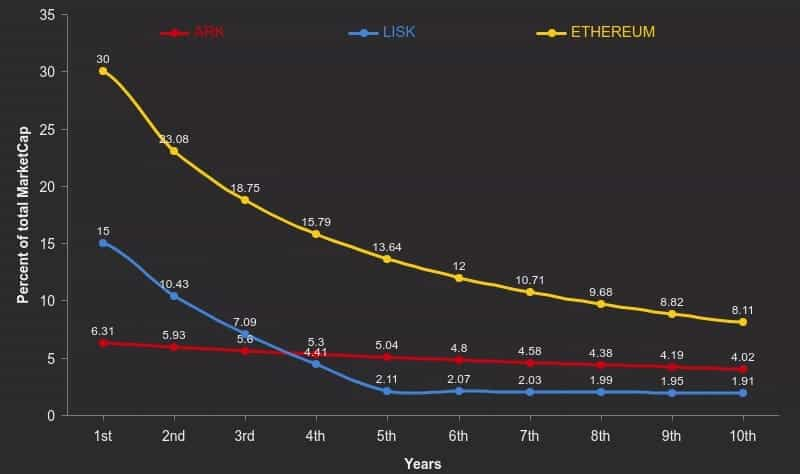
The 8 second block time is one of the faster among cryptocurrencies. Ethereum is close with a 14 second block time, but Bitcoin has a 10 minute block time.
In addition to have fast block times, each block can process 25 transactions. While this is good, the ARK team has already stated in their whitepaper that they will make this scalable by increasing the number of transactions processed by each block, as well as lowering the block time.
Token Fees
As of v2 ARK has transitioned to a dynamic fee structure in which the delegates set their minimum acceptable fee for each transaction, and users also set the fee they are willing to pay for a transaction. There are also maximum allowed fees for each transaction type, which are the same as the static fees that were used in v1 of ARK.
These dynamic fees don’t just apply to send/receive transactions, it also applies to voting for delegates and registering as a delegate.
The current desktop and mobile wallets give a preset transaction value, which is the current network average fee. Advanced options also allow a user to choose between the 30-day average transaction, or a minimum and maximum selection, which are the minimum and maximum transaction value from the past 30 days.
Obviously, the higher the fee the faster the transaction is processed. In addition, the maximum fee is limited to current static fees. In addition, delegates have the option of disabling dynamic fees, meaning that they will just continue including blocks with the v1 fee model (0.1 ARK transfers, 1 ARK voting, 5 ARK 2nd signature, 25 ARK delegate registration).
ARK Performance
As with most cryptocurrencies, the price of ARK has been heavily influenced by its own developmental milestones, but also by the price of Bitcoin, which has had a huge impact on the overall cryptocurrency markets.
This means we’ve seen peaks and valleys in the price of ARK since it had its ICO in 2016. The first spike occurred in June 2017, when the token hit $1.09 after the developers released a library for Java support on the platform.
With Java being one of the most popular programming languages the community was understandably excited by the news and sent price higher accordingly. We can imagine a nice spike could occur when languages such as C++ are added.
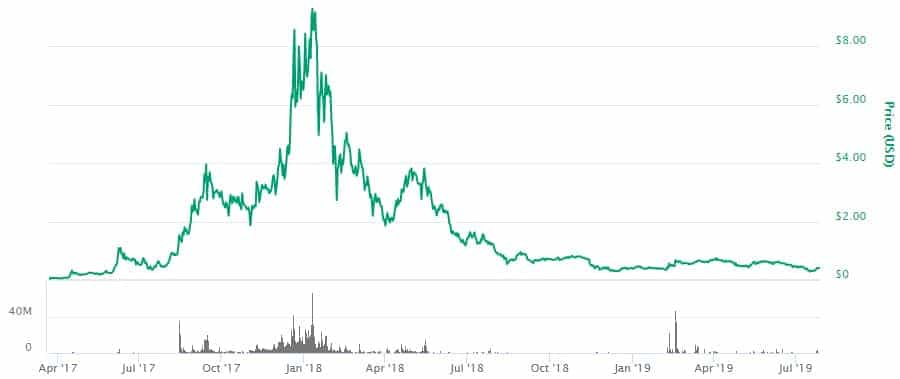
The next spike occurred in September 2017, with the price reaching $3.96 after the ARK team released a desktop wallet that fixed many reported bugs in the previous version of the desktop wallet. The update also included support for Ledger, one of the most popular hardware wallets.
The largest spike came in January 2018 as the entire cryptocurrency market rallied. Price hit $10.91 on January 9, 2018, but it then fell throughout 2018 as the entire cryptocurrency market entered a bear phase.
New lows around $0.30 were reached in December 2018. Since then the price has increased, and traded in a range of roughly $0.50 to $0.70 throughout much of 2019. More recently it has pulled back and as of July 26, 2019, it trades at just above $0.40.
When you consider that the ICO price of ARK was $0.10 back in November/December 2016 you can see that ARK has primarily remained a good investment, especially for those able to maintain a delegate node.
Buying & Storing ARK
The largest trading markets for ARK are Binance, UpBit, and Bittrex. On Binance both BTC and ETH are popular trading pairs, while Bittrex sees primarily BTC trades.
UpBit has the Korean Won as the most popular exchange, although BTC trades are also well represented. ARK also sees trading on OKEx and the largest trade volume there is against USDT. There are some smaller exchanges offering ARK, but volumes are quite small.
When it comes to ARK turnover on Binance, it seems to be pretty reasonable. This means that there are decent levels of liquidity which makes it easier to execute large block orders with relatively little slippage.

The easiest place to store your ARK is in one of the wallets provided on their site. You have three options:
- Desktop Wallet
- Paper Wallet
- Web Lite Wallet
The desktop wallet is a very good choice as the design is quite good and usability is excellent. You could also use the Ledger hardware wallet if you’re after more security.
Or for those on the go there are mobile versions of the ARK wallet for both Android and iOS. Both versions are rated 5-stars, though to be sure they haven’t had many reviews to date.
ARK Delegate Voting
If you’re planning on buying and holding ARK you probably want to vote for a delegate as soon as you get your ARK off the exchange and into your own wallet. It’s only 1 ARK to do so, and you can use the vote on a delegate that will pay you dividends, which should allow you to recover the cost of voting in the first place. Or if you prefer you can find a delegate who’s working on a cool project you’d like to support.
Voting is easy. Once you have at least 1 ARK in your wallet simply navigate to the “Votes” tab. Once there you’ll click “Add Delegate” and you’ll get a pop-up where you can vote for one of the 51 existing delegates, or if you like you can enter the name of another user you’d like to vote for. Choose a delegate and make sure the checkbox next to your chosen delegate is checked and then click “Vote”.
Finally you’ll need to enter your passphrase to confirm your vote. You can change your delegate vote anytime, but you will have to pay 1 ARK each time you do so.
Ark Development & Roadmap
It can sometimes be hard to determine exactly how much work has been done on project. It is often a case of the development team over-inflating the progress that has been made.
For me, the proof is often in the pudding.
Therefore, one of the best ways to observe progress is through the coding activity in their public code repositories. I decided to jump into the Ark Ecosysem GitHub to get an exact sense of this. Below are the code commits for the top three pinned repositories.
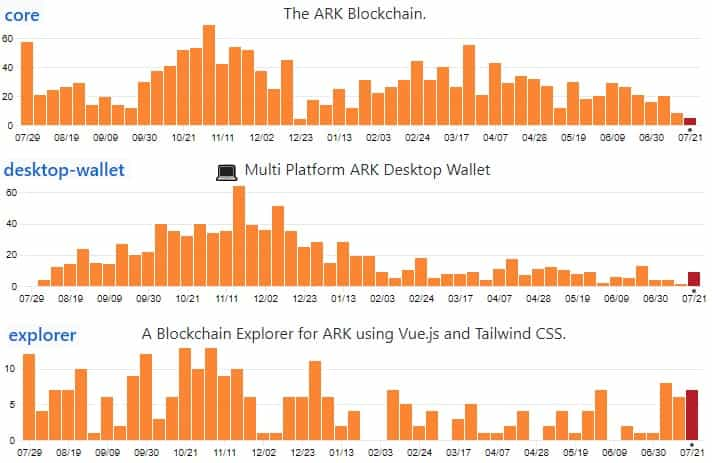
As you can see, there has been extensive activity in these repositories over the past year. It is also worth pointing out that there are a further 72 other repositories with varying degrees of activity.
If we were to compare this to other projects in the space, ARK is ranked quite high. In fact, according to CoinCodeCap, they come in number 24 placing them just between the Kyber Network and Nexus.
This is really quite impressive and bodes well for the Ark developers and community members. If you wanted to get more perspective on this development activity then they have their Ark.io site and GitHub to track updates & stats.
All of this activity makes sense when viewed in conjunction with their broader roadmap. Over the past year they have completed ARK Core V2, the Developer GUI, a second Whitepaper and a new website (amoung many others).
They are also currently in the process of building out ARK Core v2.6 at about 68% completion. This is expected to be fully complete by the end of Q3 2019.
And then, coming in Q4 we can expect to see further work on the Core as they begin development on v3.0. Add to that work on the new mobile wallet as well as updates to the website.
If you wanted to keep up to date with the progress on this as well as the milestones then they have an extensive roadmap page. It will also break down the progress on individual tasks within these milestones.
Conclusion
The ARK team looks to be building a useful resource for the blockchain ecosystem as a whole. They may not be the only project trying to connect disparate blockchains, but that doesn’t make their work any less valuable, especially if they end up succeeding where others fail.
The roadmap being followed by the team is quite ambitious, but that simply means if the team is successful they should be wildly successful. The newest Core v3 is due to be released by the end of 2019, which will include a new GUI dashboard for node management, as well as updated consensus and voting logic. Even more exciting is the Q1 2020 release of phase 1 of the ARK Marketplace.
The ARK Marketplace will be an all-new property built from the ground up to give the entire Bridgechain Community one central location to Build, Discover, and Learn about the entire ARK Ecosystem. The initial Phase 1 launch will include some of the most important aspects of the ARK Ecosystem including Delegates, Businesses, Bridgechains, and Plugins.
Personally, I like this type of project that aims to create a useful user interface and make blockchain technology accessible by the masses. I could see ARK becoming one of the long term survivors in the blockchain revolution.
Disclaimer: These are the writer's opinions and should not be considered investment advice. Readers should do their own research.
Disclaimer: These are the writer’s opinions and should not be considered investment advice. Readers should do their own research.
